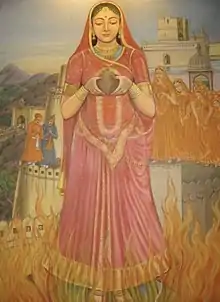Rani Karnavati
Rani Karnavati also known as Rani Karmavati (died 8 March 1534), was a princess and temporary ruler from Bundi, India. She was married to Rana Sanga of Chittorgarh, the capital of Mewar Kingdom. She was the mother of the next two Ranas, Rana Vikramaditya and Rana Uday Singh, and grandmother of the legendary Maharana Pratap. She served as regent during the minority of her son, from 1527 until 1533. She was as fierce as her husband and defended Chittor with a small contingent of soldiers until it inevitably fell to the Gujarat army. She refused to flee and performed Jauhar to protect her honour.
| Rani Karnavati | |
|---|---|
 | |
| Died | 8 March 1534 |
| Spouse | Rana Sanga |
| Issue | Vikramaditya Udai Singh II |
| Father | Rao Nirbudh of Bundi |
| Mother | Rani Sa of Bundi |
Biography
After Babur had captured the throne of Delhi in 1526 AD, Rana Sangram Singh or Rana Sanga of Mewar lead a confederation of Rajput Kings against Babur to capture the throne of Delhi. But in The Battle of Khanua in 1527, the combined Rajput forces were defeated, and Rana Sanga poisoned by his colleagues.
Rani Karnavati took up the regency in the name of her elder son Vikramaditya, a weak ruler. In the meantime, Mewar was attacked for the second time by Bahadur Shah of Gujarat, at whose hands Vikramaditya had earlier received a defeat. It was a matter of great concern for Rani.
The antagonized nobles were not ready to fight for Vikramaditya and the imminent battle was sure to be another blot in the history of Sisodias. Rani Karnavati wrote to the nobles to come forward for the sake of the honour of the Sisodias, and was able to persuade the nobles to fight for Mewar, if not for Vikramaditya. Their sole condition was that Vikramaditya and Uday Singh should go to Bundi during the war for their personal safety. Some later legends say that the Rani also sent a Rakhi to the Mughal Emperor Humayun, calling him a brother and asking for help. Thus her name became irrevocably linked to the festival of Raksha Bandhan. However this is not supported by any contemporary writer and modern historians like Satish Chandra consider this to be a fable rather than a historical fact.[1]
Rani Karnavati agreed to send her sons to Bundi and told her trusted maid Panna Dai to accompany them and take good care of them. Panna was reluctant, but surrendered to the wishes of the queen, when she assured her that with the renewed support of the nobles and the expected help from Humayun, all would be well. However, tidings from Chittor were not good and the Sisodias had fought valiantly, but they were outnumbered and the war was lost. Humayun who was on Bengal's invasion but after hearing the news of Chittor siege he left the Bengal expedition midway, but in those times, journey by elephants and horses took considerable time and owing to this he reached after the war had ended in Bahadur Shah's favour.[2] Bahadur Shah entered Chittorgarh and ransacked it for the second time.
Realising that defeat was imminent, Karnavati and the other noble ladies of the court immolated themselves in a mass suicide by fire known as Jauhar on March 8, 1534 A.D., while all the men donned saffron clothes and went out to fight to the death and thus committed saka. This is the occasion for the second of the three Jauhars performed at Chittor.[3][4] Later, Humayun captured Chittor from Bahadur Shah on his way back to Gujarat by capturing Mandu in 1535.
Notes
- History of Medieval India by Satish Chandra pg.212
- Diaspora of Muslims by Everett Jenkins, Jr.'
- Encyclopaedia of Indian Events & Dates
- KARNAVATI, QUEEN OF CHITTOR
External links
- Stones of Rajput valour at Business Line, The Hindu, April 10, 2000